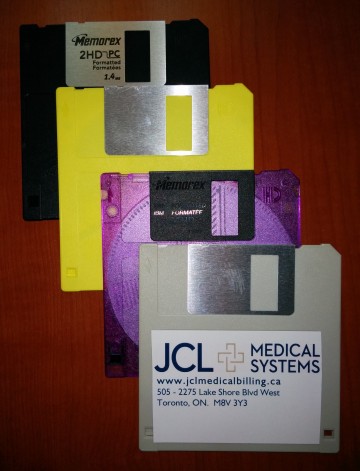All physicians in Ontario routinely send claim files to the Ministry of Health and Long Term Care so they can be paid for the work they do. Physicians also receive reports regularly from the Ministry. These include error reports, batch confirmations, and monthly remittance advice reports that together ensure claims are paid properly and bills can be reconciled.
Over the past year, the MOHLTC has been promoting its latest medium of sending and receiving files. This new method, called Medical Claims Electronic Data Transfer or MCEDT for short, is a web-based portal allowing physicians or their billing agents to upload and download files.
Time for a history lesson
 If you were a doctor starting to practice in 1994, the internet was in its infancy. So how did physicians send and receive files 20 years ago? Using a 3.5 inch floppy disk of course. Claim files would be created with all the relevant billing data and copied to a floppy disk, which was then mailed (or hand-delivered!) to the local OHIP office. If your disk didn’t arrive by the 18th of the month, you did not get paid. RA reports were sent back the same way, by diskette. Error reports were printed by the Ministry and mailed to doctors and took about 3 weeks to arrive! From hand delivered, printed materials to instant web delivery – we’ve come a long way.
If you were a doctor starting to practice in 1994, the internet was in its infancy. So how did physicians send and receive files 20 years ago? Using a 3.5 inch floppy disk of course. Claim files would be created with all the relevant billing data and copied to a floppy disk, which was then mailed (or hand-delivered!) to the local OHIP office. If your disk didn’t arrive by the 18th of the month, you did not get paid. RA reports were sent back the same way, by diskette. Error reports were printed by the Ministry and mailed to doctors and took about 3 weeks to arrive! From hand delivered, printed materials to instant web delivery – we’ve come a long way.
Thankfully, if you were a doctor starting practice in 2004, things had changed considerably. The ministry had moved from diskette transmission to EDT or Electronic Data Transfer. Files were still created, but instead of copying them to diskettes, doctors or their billing agents would connect to the ministry with a dial-up modem. Most physicians are surprised to learn that dial up modem is still the most common way of submitting files for established doctors. Several times each day at our office, you will hear the familiar beeping/buzzing/and whistling sound of our dial up modem connecting to EDT to send or receive files.
The future is here
Well, it is now 2014, and time for the next step in the evolution of file transmission. The ministry is planning on abandoning EDT file transmission by the end of this year and only allowing submission through MCEDT as of January 1st, 2015.
This new method of data transfer has some advantages over it’s predecessor. For one, MCEDT solves one of the principal drawbacks of the old system – sharing files. Under EDT, the Ministry would send error reports and RA files to one and only one EDT user. Physicians who work at multiple settings with multiple billing staff had to make sure all reports from the Ministry were sent to the correct staff. It was a hassle. On MCEDT, however, doctors can give access to multiple designees. Physicians working at multiple locations will find this a relief, as will their billing agents.
The only challenge we’ve seen so far with MC-EDT is the initial set up. Doctors have to set up their own accounts following instructions from the Ministry. This has turned out to be difficult for some physicians, especially those who are not that tech savvy. To help clear things up a bit, in the next blog post we will walk readers through the MCEDT registration process.
